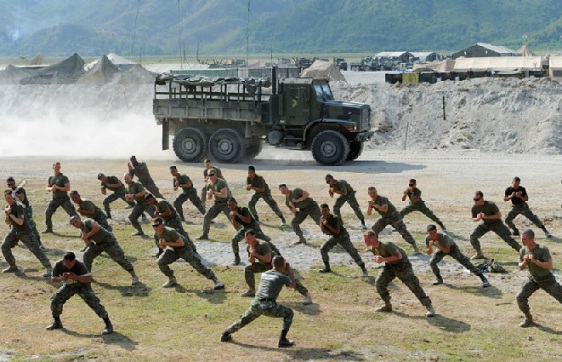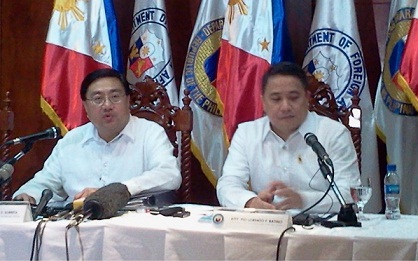Both panels have agreed that the agreement they are negotiating will be titled “Increased Rotational Presence (IRP) Framework Agreement.
Their answers, however, lead to more questions because they are fond of using big words that make you wonder whether they are referring to a thing or a creature or whatever. They also give incomplete information which does not make for a truthful answer.
Examples:
First question is what is IRP.
Answer: “Increased Rotational Presence is the policy which increases the presence of United States (US) forces on a rotational basis in Philippine territory towards the development of a minimum credible defense posture.
With this answer, the public is given the idea of a revolving arrangement. Something like the 300 American soldiers who would be in the Philippines in January would leave February to be replaced by another batch. That means, whatever batch they are, there will always be American soldiers in the Philippines. American presence will be a fixture then in the Philippines. Something like a permanent presence.
 Isn’t that circumventing the Constitutional prohibition which states: “After the expiration in 1991 of the Agreement between the Republic of the Philippines and the United States of America concerning Military Bases, foreign military bases, troops, or facilities shall not be allowed in the Philippines except under a treaty duly concurred in by the Senate….”
Isn’t that circumventing the Constitutional prohibition which states: “After the expiration in 1991 of the Agreement between the Republic of the Philippines and the United States of America concerning Military Bases, foreign military bases, troops, or facilities shall not be allowed in the Philippines except under a treaty duly concurred in by the Senate….”
There is no answer in the FAQ to that question.
In explaining what IRP is, the phrase “minimum credible defense posture” is mentioned.
They explained “minimum credible defense posture” as “intended to enhance maritime domain awareness and develop a deterrence capability. This can be accomplished through high-impact and high-value joint exercises which promote interoperability and capacity building that will also bolster humanitarian assistance and disaster response.”
Big words: maritime domain awareness, deterrence capability, high-value joint exercises.
Who was the smart guy man who said that if you want to hide something, use words that are difficult to understand. That’s the feeling we have reading these phrases.
We asked a member of the Philippine panel, Foreign Affairs Assistant Secretary Carlos Sorreta to explain to us those big words and his reply, by text: “ For Maritime Domain Awareness, we use the generally accepted definition adopted by the International Maritime Organization which is the effective understanding of anything associated with maritime domain that could impact the security, economy, or environment.”
What, again?
We also asked Soreta for an explanation to another of their favorite buzzwords: maritime security.
Here’s Soreta’s explanation: “The definition of maritime security and the threats involved is in EO 57 dated 6 Sept.2011 establishing the National Coast Guard Watch System and can be found in www.pcoo.gov.ph issuances/issuances-eo/EO-57.pdf.”
E.O 57 states that NCWS would be dealing with threats such as terrorism, transnational crimes, drug and firearms trafficking, smuggling, human trafficking, climate change, illegal fishing, marine environment degradation and other security concerns.”
We are having nosebleed. We hope in the next FAQs, they break them down to simple, non-threatening sentences.
Another question: How is the proposed IRP Framework Agreement different from the existing MDT with the US and the VFA?
MDT is the 1951 RP-US Mutual Defense Treaty while VFA is the 1998 RP-US Visiting Forces Agreement.
Answer: The IRP Framework Agreement is already within the ambit of the existing MDT and VFA. By this IRP Framework Agreement, we are merely institutionalizing a fuller and more effective implementation of the MDT and VFA.
We have serious doubts about this in the context of the non –extension of the Military Bases Agreement in 1991 and the lack of transparency on the exact nature of the increased American presence in the country.
Another question: Will the US come to the defense of the Philippines when attacked?
Answer: The US has, time and again, stated that it will honor its commitments under the MDT.
The FAQs do not say that the MDT states that “Each Party recognizes that an armed attack in the Pacific area on either of the Parties would be dangerous to its own peace and safety and declares that it would act to meet the common dangers in accordance with its constitutional processes.”
It is doubtful if future FAQs will explain that particular provision of the MDT and what “constitutional processes” means. Which is,heaven forbid, if the Philippines is attacked the President of the United States will ask US Congress how they would respond. In a democracy, the process could take months. That means while the U.S. go through their “constitutional processes” the Philippines would be left alone to fend for itself.
Those FAQs should be checked against reality.
Please click here for the complete FAQs:FAQs on the IRP Framework Agreement
